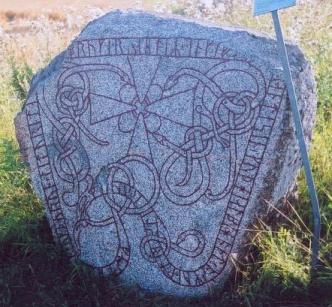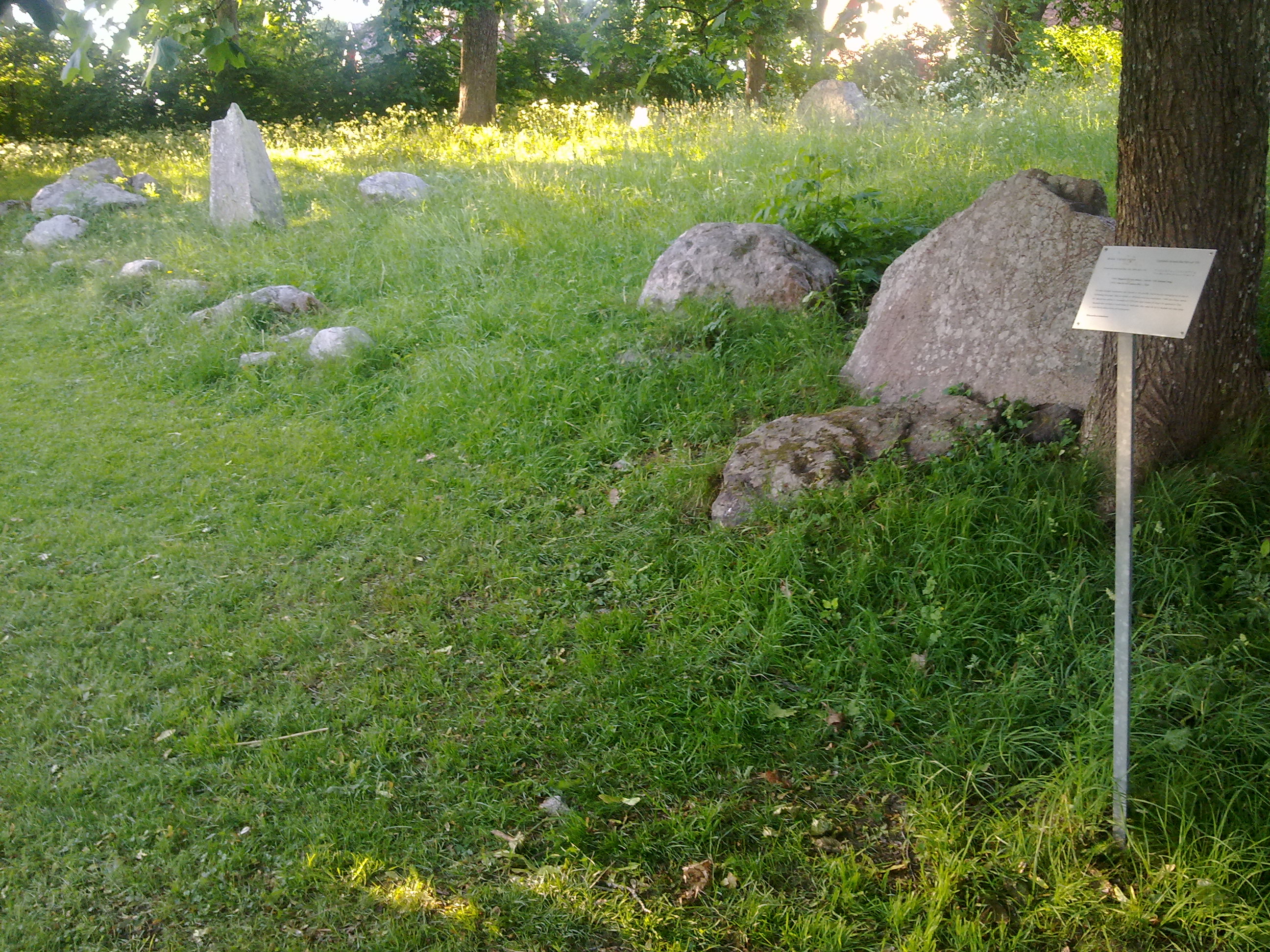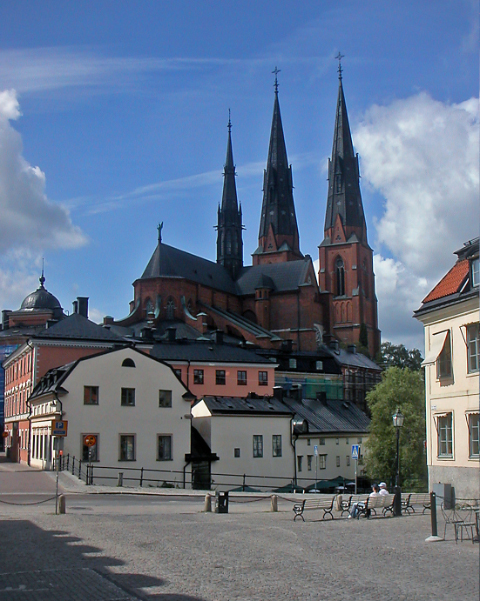|
Uppland Runic Inscription Fv1986 84
Runic inscription U Fv1986;84 is the Rundata catalog number for a Viking Age memorial that is located at Bo gård on the island of Lidingö in Uppland, Sweden. Description This runestone was discovered in 1984 and is carved on a boulder located on the island of Lidingö. The inscription, which is about 2 meters high by 1.4 meters wide, consists of runic text carved on an intertwined serpent. There is a Christian cross near the top of the design. The inscription is classified as being carved in runestone style Pr3 - Pr4, which is also known as the Urnes style. This runestone style is characterized by slim and stylized animals that are interwoven into tight patterns. The animal heads are typically seen in profile with slender almond-shaped eyes and upwardly curled appendages on the noses and the necks. The runic text begins at the bottom of the inscription and reads clockwise along the serpent. The text states that the runemaster Åsmund carved the runes in memory of his grandfat ... [...More Info...] [...Related Items...] OR: [Wikipedia] [Google] [Baidu] |
Runic Inscription Kvarnbacken Lidingo SWE
Runes are the letters in a set of related alphabets known as runic alphabets native to the Germanic peoples. Runes were used to write various Germanic languages (with some exceptions) before they adopted the Latin alphabet, and for specialised purposes thereafter. In addition to representing a sound value (a phoneme), runes can be used to represent the concepts after which they are named (ideographs). Scholars refer to instances of the latter as ('concept runes'). The Scandinavian variants are also known as ''futhark'' or ''fuþark'' (derived from their first six letters of the script: '' F'', '' U'', '' Þ'', '' A'', '' R'', and '' K''); the Anglo-Saxon variant is ''futhorc'' or ' (due to sound-changes undergone in Old English by the names of those six letters). Runology is the academic study of the runic alphabets, runic inscriptions, runestones, and their history. Runology forms a specialised branch of Germanic philology. The earliest secure runic inscriptions date from aro ... [...More Info...] [...Related Items...] OR: [Wikipedia] [Google] [Baidu] |
Åsmund Kåresson
Åsmund Kåresson was a Viking Age runemaster who flourished during the first half of the 11th century in Uppland and Gästrikland, Sweden. The early Urnes style is represented in his art. pp. 197, 208–09. Work Most early medieval Scandinavians were probably literate in runes, and most people probably carved messages on pieces of bone and wood.Vilka kunde rista runor?' on the Swedish National Heritage Board website, retrieved January 13, 2007. However, it was difficult to make runestones, and in order to master it one also needed to be a stonemason. During the 11th century, when most runestones were raised, there were a few professional runemasters. Åsmund was active mainly in Uppland, and about twenty runestones are signed by him and an additional thirty stones have been attributed to him. The ornamentation is characterized by variation with firmness and security in the composition. Åsmund is the inventor of the classic Uppland runestone style with one or two animals (''rundjur ... [...More Info...] [...Related Items...] OR: [Wikipedia] [Google] [Baidu] |
Mälaren
Mälaren ( , , or ), historically referred to as Lake Malar in English, is the third-largest freshwater lake in Sweden (after Vänern and Vättern). Its area is 1,140 km2 and its greatest depth is 64 m. Mälaren spans 120 kilometers from east to west. The lake drains, from south-west to north-east, into the Baltic Sea through its natural outlets Norrström and Söderström (as it flows around Stadsholmen island) and through the artificial Södertälje Canal and Hammarbyleden waterway. The easternmost bay of Mälaren, in central Stockholm, is called Riddarfjärden. The lake is located in Svealand and bounded by the provinces of Uppland, Södermanland and Västmanland. The two largest islands in Mälaren are Selaön (91 km2) and Svartsjölandet (79 km2). Mälaren is low-lying and mostly relatively shallow. Being a quite narrow and shallow lake, Mälaren has bridge crossings between Eskilstuna and Västerås with two crossings on the western end at Kvicksund and t ... [...More Info...] [...Related Items...] OR: [Wikipedia] [Google] [Baidu] |
Scandinavia
Scandinavia; Sámi languages: /. ( ) is a subregion#Europe, subregion in Northern Europe, with strong historical, cultural, and linguistic ties between its constituent peoples. In English usage, ''Scandinavia'' most commonly refers to Denmark, Norway, and Sweden. It can sometimes also refer more narrowly to the Scandinavian Peninsula (which excludes Denmark but includes part of Finland), or more broadly to include all of Finland, Iceland, and the Faroe Islands. The geography of the region is varied, from the Norwegian fjords in the west and Scandinavian mountains covering parts of Norway and Sweden, to the low and flat areas of Denmark in the south, as well as archipelagos and lakes in the east. Most of the population in the region live in the more temperate southern regions, with the northern parts having long, cold, winters. The region became notable during the Viking Age, when Scandinavian peoples participated in large scale raiding, conquest, colonization and trading mostl ... [...More Info...] [...Related Items...] OR: [Wikipedia] [Google] [Baidu] |
Uppland Runic Inscription 1144
Uppland Runic Inscription 1144 or U 1144 is the Rundata catalog designation of a Viking Age memorial runestone in a churchyard that is located five kilometers southwest of Tierp, Uppsala County, Sweden, which was in the historic province of Uppland. Description The runic inscription consists of runic text within bands that are around an unusual image of a Christian cross surrounded by stylized serpents and two lambs. It has been suggested that the runestone's iconography of an adoring lamb on each side of the cross may have been based on similar images seen during pilgrimages to Rome or the Holy Land. The stone is composed of granite and is 1.8 meters in height with the upper right portion missing. The inscription is classified as being carved in runestone style Pr3, which is also known as Urnes style. This runestone style is characterized by slim and stylized animals that are interwoven into tight patterns. The animal heads are typically seen in profile with slender almond-sh ... [...More Info...] [...Related Items...] OR: [Wikipedia] [Google] [Baidu] |
Bolsta Runestones
The Bolsta Runestones are two Viking Age memorial runestones and two fragments of a third that are located in Bolsta, which is on the east edge of Uppsala, Uppsala County, Sweden, and in the historic province of Uppland. One runestone is signed by the runemaster with the normalized name of Åsmund Kåresson and the other by the runemaster named Öpir. U 968 Upplands Runic Inscription 968 or U 968 is the Rundata catalog listing for two fragments of a runestone that are 0.6 and 0.8 meters in height. The inscription consists of runic text carved in the younger futhark on a serpent. The inscription was recorded during the initial Swedish runestone surveys of the 1600s, but the stone later disappeared. Before the historic nature of runestones was understood, they were often reused as materials in the construction of churches, buildings, and walls. Two fragments of the stone were found in the basement of a village house in the 1880s, and are now located on private property. The insc ... [...More Info...] [...Related Items...] OR: [Wikipedia] [Google] [Baidu] |
Uppsala Cathedral
Uppsala Cathedral ( sv, Uppsala domkyrka) is a cathedral located between the University Hall of Uppsala University and the Fyris river in the centre of Uppsala, Sweden. A church of the Church of Sweden, the national church, in the Lutheran tradition, Uppsala Cathedral is the seat of the Archbishop of Uppsala, the primate of Sweden. It is also the burial site of King Eric IX (c. 1120–1160, reigned 1156–1160), who became the patron saint of the nation, and it was the traditional location for the coronation of new Kings of Sweden. The current archbishop is Martin Modéus and the current bishop is Karin Johannesson. The cathedral dates to the late 13th century and, at a height of , it is the tallest church in the Nordic countries. Originally built under Roman Catholicism, it was used for coronations of Swedish monarchs for a lengthy period following the Protestant Reformation. Several of its chapels were converted to house the tombs of Swedish monarchs, including Gustav Vas ... [...More Info...] [...Related Items...] OR: [Wikipedia] [Google] [Baidu] |
Uppland Runic Inscription 871
U 871 is a 12th-century runestone in the Rundata catalog, originally from Ölsta, a village in the county of Uppland in Sweden. It is now on display at Skansen, near Stockholm. Description It is believed that this stone remained in its original place until 1896. The spot was close to the Eriksgata, the road that the Swedish king travelled after having been elected at the Stone of Mora, in order to be accepted by his subjects. The stone was sold for 50 Swedish kronor in 1896 to the founder of Skansen, Artur Hazelius, where it was moved. It remains at Skansen to this day. The inscription is classified as being carved in runestone style Pr4, which is also known as the Urnes style. This runestone style is characterized by slim and stylized lindworms that are interwoven into tight patterns. The animal heads are typically seen in profile with slender, almond-shaped eyes and upwardly curled appendages on the noses and the necks. The inscription is signed by the runemaster Åsmund Kåre ... [...More Info...] [...Related Items...] OR: [Wikipedia] [Google] [Baidu] |
Uppland Runic Inscription 824
Uppland Runic Inscription 824 is the Rundata catalog number for a Viking Age memorial runestone located at Holms, which is about eight kilometers east of Örsundsbro, Uppsala County, Sweden, and in the historic province of Uppland. The inscription features a facial mask and a bind rune in the text. Description This inscription consists of runic text carved on a serpent that is intertwined with and encircles other serpents. The inscription is classified as being carved in either runestone style Pr3 or Pr4, both of which are considered to be Urnes style. This runestone style is characterized by slim and stylized animals that are interwoven into tight patterns. The animal heads are typically seen in profile with slender almond-shaped eyes and upwardly curled appendages on the noses and the necks. At the top of the inscription but within the outer serpent is a mask of a man's face. This is a common motif and is found on several other runestones including DR 62 in Sjelle, DR 66 in ... [...More Info...] [...Related Items...] OR: [Wikipedia] [Google] [Baidu] |
Baltic Area Runestones
The Baltic area runestones are Varangian runestones in memory of men who took part in peaceful or warlike expeditions across the Baltic Sea, where Finland and the Baltic states are presently located. Beside the runestones treated in this article and in the main article Varangian runestones, there are many other runestones that talk of eastward voyages such as the Greece runestones, Italy runestones, and inscriptions left by the Varangian Guard. Other runestones that deal with Varangian expeditions include the Ingvar runestones (erected in honor or memory of those who travelled to the Caspian Sea with Ingvar the Far-Travelled). In addition, there were also voyages to Western Europe mentioned on runestones that are treated in the articles Viking runestones, England runestones and Hakon Jarl runestones. Below follows a presentation of the runestones based on the Rundata project. The transcriptions into Old Norse are mostly in the Swedish and Danish dialect to facilitate comp ... [...More Info...] [...Related Items...] OR: [Wikipedia] [Google] [Baidu] |


.jpg)



